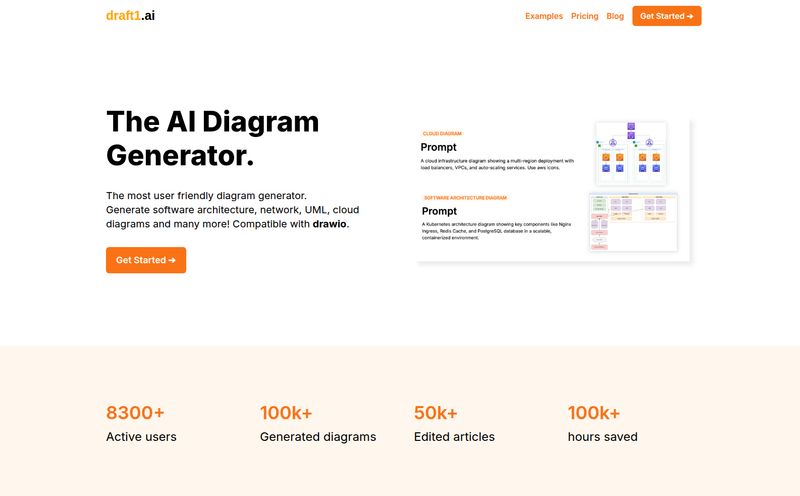We’ve all been there. It's 3 AM. Your phone buzzes, not with a late-night text, but with a PagerDuty alert that rips you from your dreams. The site is down. An application has crashed. And now, your peaceful night has transformed into a frantic, coffee-fueled code-spelunking expedition. It’s a rite of passage for anyone in development or DevOps, but man, does it get old.
So, whenever a tool comes along promising to be a “Crash Care Companion,” my ears perk up. Enter Nadi. The promise is simple and alluring: a dedicated platform to monitor your applications, catch crashes the moment they happen, and give you the clues to fix them fast. It sounds great, right? A paramedic for your PHP code. A guardian angel for your Laravel project.
There's just one, tiny, slightly hilarious problem. As I’m writing this, the Nadi website is down. Yep. A Cloudflare Error 521, for those keeping score at home. The irony is so thick you could cut it with a knife. But hey, let's not judge a book by its currently-offline cover. Let's dig into what Nadi promises to be, assuming it returns from the digital ether.
So, What Exactly is Nadi Supposed to Be?
Putting aside the current server woes, Nadi positions itself as a specialized monitoring tool. It’s not trying to be an all-in-one behemoth like Datadog or New Relic. Its focus is tighter, centered on one of the most painful parts of the application lifecycle: when things break.
The core idea is to move from reactive to proactive. Instead of waiting for a user to email you saying, “Hey, I got a 500 error when I tried to check out,” Nadi aims to tell you about the crash, what caused it, and where in your code the problem lies, often before you even knew it happened. It’s about shortening that chaotic gap between “uh-oh” and “all fixed.” For any team, that’s a pretty compelling proposition.
The Core Features: A Look Under the Hood
Every tool is just a collection of features, so what’s in Nadi’s toolkit? Based on the information available, it boils down to a few key areas.

Visit Nadi
Real-Time Application Monitoring
This is table stakes for any monitoring tool. It means having a live dashboard that shows you the pulse of your application. You're not just looking at log files from yesterday; you're seeing what's happening now. Is performance dipping? Are error rates spiking? This is the high-level view that helps you spot trouble before it becomes a catastrophe.
The Main Event: Crash Detection and Investigation
This is Nadi’s bread and butter. When an unhandled exception occurs, Nadi catches it. But it does more than just log the error message. It's designed to provide a full stack trace, information about the server environment, and the request data that triggered the crash. Think of it as a black box flight recorder for your application. When it goes down, you have a detailed record of its last moments, which makes the post-mortem investigation infinitely easier.
Centralized Management and Issue Tracking
If you're a solo developer, maybe you can keep track of bugs in a text file (I’ve done it, no shame). But on a team, you need a single source of truth. Nadi seems to incorporate some level of issue tracking, allowing you to manage crashes from discovery to resolution within one platform. This helps prevent the classic scenario where a bug is reported in Slack, discussed in an email thread, and then completely forgotten until a customer complains again.
A Nod to the PHP Crowd (Polyglot Support)
Nadi specifically calls out support for Laravel, PHP, and CakePHP. This tells me a lot about their target audience. They're not trying to capture the entire market of Python, Ruby, and Go developers from day one. They're focusing on the massive PHP community, which is a smart move. There are millions of PHP applications out there, and a tool built with their stack in mind is always welcome.
The Good, The Bad, and The... Offline?
Alright, let's get into the nitty-gritty. No tool is perfect, and from what I can see, Nadi has some clear strengths and some pretty big question marks.
On the plus side, the real-time, focused approach to crash reporting is a huge win. Getting that immediate, detailed feedback loop is how you build more stable applications and keep your on-call engineers sane. Centralizing everything is also a major quality-of-life improvement for any development team.
However, there are some hurdles. The biggest, most glaring one is that the website is down. I can't stress this enough. For a service that sells uptime and stability, having your own host server be unresponsive is, to put it mildly, not a good look. It's like a security company getting hacked. It completely undermines confidence. I’m hoping it’s a temporary issue, maybe a botched deployment or a server migration, but it’s a five-alarm fire from a marketing perspective.
Another point of friction is the lack of detail on features beyond crash reporting. What does “Application Management” truly entail? Is it just a list of my connected apps, or does it offer more? The information feels a little thin. It also seems like it might require a bit of technical savvy to get up and running, which could be a barrier for less experienced teams.
Nadi Pricing: The Million-Dollar Question (Literally)
So how much does this all cost? Your guess is as good as mine. There is absolutely no pricing information available. The pricing page URL is empty. This is a personal pet peeve of mine. I understand the “Contact Us for a Demo” model for massive enterprise software, but for a tool seemingly aimed at developers and small-to-medium teams, transparent pricing is king.
Is it a freemium model? Is it tiered based on the number of events or users? We just don't know. This lack of transparency makes it impossible to evaluate Nadi against competitors like Sentry or Bugsnag, many of whom offer generous free tiers. It's a major roadblock for anyone wanting to give it a try.
Who is Nadi For? (If It Comes Back Online)
Assuming Nadi resolves its… availability issues… it seems perfectly suited for a specific type of user. I see this being a great fit for:
- PHP Freelancers and Agencies: Managing multiple client sites built on Laravel or vanilla PHP? A tool like this could be a godsend for staying on top of issues across your entire portfolio.
- Small to Medium-Sized Businesses: If your core product is a PHP-based web application, Nadi offers a focused solution without the complexity and cost of a larger observability platform.
- Devs Who Just Want to Fix Bugs: Sometimes you don't need a million charts and graphs. You just need to know when your code breaks and why. Nadi promises to deliver exactly that.
It's probably not for the huge enterprise that needs integrated APM, logging, and infrastructure monitoring all in one place. And that's fine! Niche tools are often more effective than one-size-fits-all solutions.
My Final Thoughts on Nadi
I want to like Nadi. I really do. The concept is solid. The focus on being a “Crash Care Companion” is a great marketing angle, and its stated support for the PHP ecosystem is smart. In a world of overly complex SaaS tools, a simple, effective solution for a common, painful problem is always welcome.
But I can't ignore the massive elephant in the room. You can’t sell a service based on reliability when your own front door is locked. Until the website is back up and they provide clear, transparent pricing, Nadi remains a promising idea rather than a viable tool. I'm rooting for them, honestly. I've bookmarked the site, and I’ll be checking back. If they can get their own house in order, they might have something really useful here. For now, it’s a story of potential… pending a server reboot.
Frequently Asked Questions
- What is Nadi?
- Nadi is a specialized software tool designed to be a “Crash Care Companion” for applications. Its main purpose is to monitor applications, detect when they crash, and provide developers with detailed information to help them identify and fix the root cause of the problem quickly.
- What languages does Nadi support?
- Based on the available information, Nadi specifically supports popular PHP frameworks and languages, including Laravel, CakePHP, and vanilla PHP.
- Is Nadi free?
- Unfortunately, we don't know. There is no public pricing information available for Nadi. Potential users cannot see if there is a free tier or what the paid plans might cost without, presumably, contacting the company directly.
- Why can't I access the Nadi website?
- As of this writing, the Nadi website (nadi.pro) is returning a Cloudflare Error 521. This error means that while your browser and Cloudflare can connect, Cloudflare could not get a response from Nadi's own web server. It suggests an issue with the origin host server being offline or blocking requests.
- What are some good alternatives to Nadi?
- For developers looking for crash reporting and application monitoring, especially in the PHP ecosystem, some popular and well-established alternatives include Sentry, Bugsnag, and Raygun. Many of these offer free tiers and have transparent pricing models.
Reference and Sources
- Nadi Official Website (Currently Inaccessible):
https://nadi.pro - Cloudflare: Understanding Cloudflare Error 521
- Sentry: https://sentry.io/
- Bugsnag: https://www.bugsnag.com/



